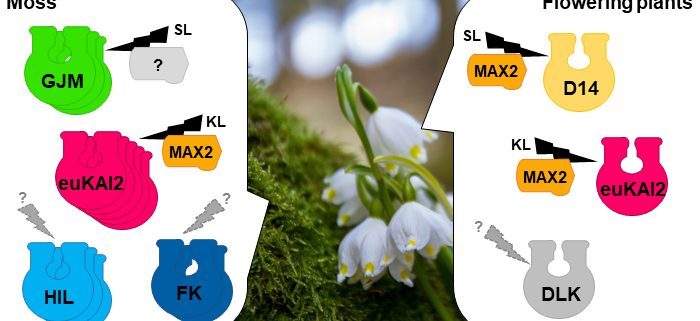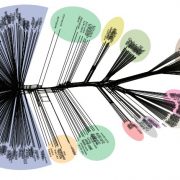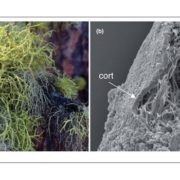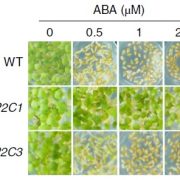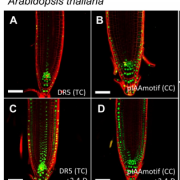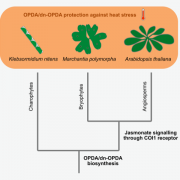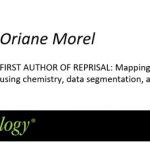A “simple” plant that’s not so basic: 13 receptors perceive SL, KL, and more in moss
By Ambre Guillory1, Mauricio Lopez-Obando2, Alexandre de Saint Germain3, and Sandrine Bonhomme3
1Laboratoire des Interactions Plantes Microbes Environnement (LIPME, INRAE), Toulouse, France
2Vedas corporación de Investigación e Innovación, Medellín, Colombia
3Institut Jean-Pierre Bourgin (IJPB), Versailles, France
Background: Strigolactones (SLs) are allelochemicals that function in the rhizosphere, as well as plant hormones with numerous roles in flowering plant development. The perception of SLs relies on a receptor called D14. D14 is encoded by the same gene family as KAI2. KAI2 functions in plant responses to exogenous karrikins (KAR), which, like SL, are butenolides. MAX2 is an F-box protein that transduces both SL and KAR signals. KAI2 is likely also the receptor of an uncharacterized hormone termed KAI2-ligand (KL). Outside of flowering plants, little is known about the roles of SLs and KL as hormones, as well as their evolutionary origins. In the moss Physcomitrium patens, SLs function in plant growth, but there is no clear homolog of D14. In addition, MAX2 is not required for the SL response in P. patens, although this moss possesses 13 KAI2-like genes (PpKAI2L).
Question: Which PpKAI2L proteins serve as SL or KL receptors?
Findings: We investigated the biological functions of PpKAI2L genes in moss vegetative development and in plant responses to synthetic SL and KL analogs using physiological and biochemical approaches. PpKAI2L proteins are grouped in four subclades: euKAI2 (proteins A to E), FK, HIL, and GJM. These proteins display different binding and cleavage specificities towards SL and KL mimics. PpKAI2L-H shows a unique Michaelian enzymatic behavior amongst characterized D14 and KAI2 proteins, for which we identified a causal amino acid residue. Proteins from the euKAI2 clade behave like KAI2 proteins from flowering plants and are good KL receptor candidates. Analysis of Ppkai2L mutant development and their responses to synthetic mimics confirmed this notion and indicated that the KL pathway in P. patens is dependent on MAX2. This analysis also suggested that the GJM clade contains SL receptors.
Next steps: Elucidating protein networks that function in SL/KL pathways in moss should clarify the mechanism of their perception. Furthermore, identifying natural ligands of PpKAI2L proteins, and determining whether they act endogenously and/or exogenously, could help explain why P. patens has retained so many PpKAI2L proteins and could shed light on the evolutionary forces that shaped the SL and KL response pathways.
Mauricio Lopez-Obando, Ambre Guillory, François-Didier Boyer, David Cornu, Beate Hoffmann, Philippe Le Bris, Jean-Bernard Pouvreau, Philippe Delavault, Catherine Rameau, Alexandre de Saint Germain, Sandrine Bonhomme (2021). The Physcomitrium (Physcomitrella) patens PpKAI2L receptors for strigolactones and related compounds function via MAX2-dependent and independent pathways. DOI: 10.1093/plcell/koab217


